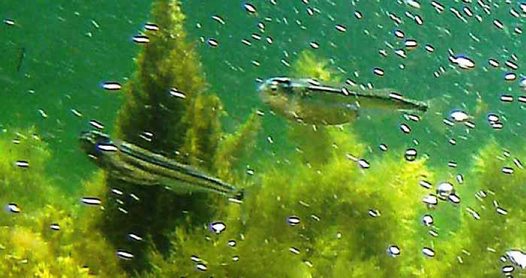by David Muirhead
I snorkelled at Myponga Beach’s south-western rock channels again this morning (29th Jan 2017) with my daughter who expressed interest in accompanying me because she’s never been in the water there. (No suits, just bathers, booties, fins, hood, mask, snorkel, SPF30+ and Sea Life camera.)
The water was clear for a change (it’s been a wet, wild warm season). Bit surgier than same time yesterday morning (tide still well in but ebbing both days, with entries around 1030 a.m.)
Today’s noticeably bigger swells, while still only about half metre, are probably why my son-in-law and I saw no surf sardines yesterday. Insufficient white-water even in the higher energy nooks then.
Today there were plenty of surf sardines! Quite enough to trick me. I saw between 20 and 30 of these lovely little fish. They were all within a few metres of the supra-tidal rocky shoreline and within the first 15 metres of the main channel – itself perhaps 40m long if one includes the more sheltered pools at either end – that we chose as our entry and exit point. This being the first decent section of long-shore channel, with moderately high relief boulders, slabs, overhangs and rock walls.
So, I tricked myself (friends often say that I’m a soft touch but I always insist I’m merely being the cautious optimist!) into being sure I’d get good images, with this happy number of subjects and in such a small and somewhat confined area. BUT they really only constituted two quite small schools of very small and almost transparent fish. And because each group repeatedly sought refuge in its favourite secondary channel.
By secondary, I mean the shallow and narrow rock channels that run across the main channel, extending from shallow subtidal to intertidal, which is where the surgy white-water was more persistent, being easily generated by all but the most gentle of swells.
I suppose yesterday’s dearth of ‘persistent’ white-water anywhere in this first big channel meant these same fish had moved a short distance further out towards the rather more exposed rocky headland, with its almost identical long-shore channels, biota, and relief, but greater wave energy.
So, what I’m getting at is simply that it was a bit hairy trying to get ANY images, without being swept onto supra-tidal rocks. Even a 3mm surf-suit would’ve helped greatly, by reducing the risk of minor skin trauma. But the water temperature was fine for wearing only bathers. Result being I only got reasonable videos of the blighters, and no good stills at all, using a Sea Life camera with no strobe.
This despite many attempts and with the fishes often milling frantically back and forth only 30-50 cm in front of lens! Boy, can they sprint away when threatened! Amazingly fast, almost freakish considering their small size, and no amount of surge deters them or slows them enough to assist photography!
Watching their dizzying, seemingly death-defying antics in the narrow confines of swell-generated white-water surge, with jagged, often bare rocks perilously near yet scarcely visible to human eyes except during brief calms between sets, and evolved to occupy such a demanding niche habitat it’s not hard to see which attributes would be on a surf sardine’s ‘must-have’ list:
Whoever are their main predators – I’m guessing bigger school fishes e.g. Australian salmon, tailor, longfin pike, perhaps barracouta and shortfin pike (snook), even kingfish; plus, many birds e.g. cormorants, terns and shearwaters – would need great sprint times and even greater agility.
Sometimes in brief absences of white-water, between swell sets, a few would leave the main school and hang about 10 cm under an equally small school of baby yellow-eye mullet of similar length -about 6 to 8cm – which seemed to like hiding in the same channels.
Some sort of protection from birds diving from above the surface?
That’ll be all for now, but I must return for another shot at getting good stills of these infuriating yet beguiling fish!
(Many of David’s previous attempts at photographing surf sardines can be seen at https://mlssa.org.au/2015/01/29/surf-sardines-and-silver-fish/ . )

